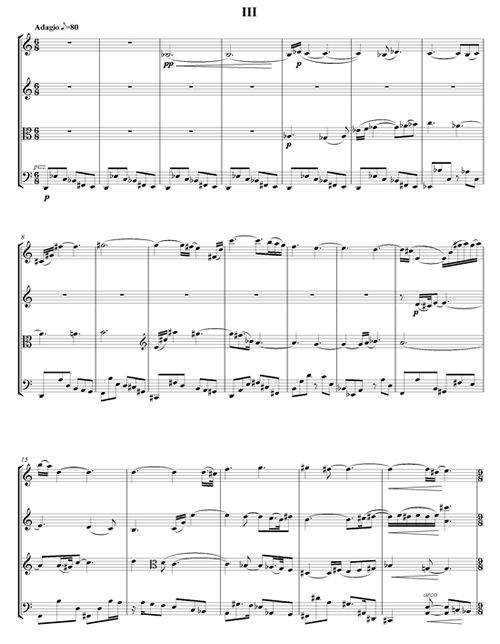Principles of Counterpoint – Instrumental Counterpoint
Most traditional western instruments were originally designed to imitate the voice. In early writing for instruments there was little difference between vocal and instrumental styles: Indeed, in the Renaissance, many pieces were designated, indifferently, “for voices or viols”. However, with the increasing exploration of instrumental idioms in the Baroque, instruments acquired a specific repertoire of gestures which showed them off in a more individual way. The vocal heritage remained, but the new idioms enriched composers’ vocabulary. When a composer writes for instruments, he has a choice: He can write as though for voices (e.g. Bach, Well Tempered Keyboard, E major Fugue in Vol. 2), or he can create more typically instrumental figuration. In the event that he chooses the latter path, certain constraints, normal for vocal writing, must be rethought.
RANGE
The most obvious difference, when writing for instruments, is range: When writing for violin, the range of alto or soprano voices is irrelevant. Registers must also be treated differently on a more subtle level. For example, voices are naturally more subdued in their lower range and get louder as they rise. Certain instruments (oboe, bassoon) do the opposite. Writing all the woodwind high and expecting a full, brilliant effect, like that which would result from placing voices in their top register, runs counter to the nature of the instruments: The effect is much thinner, even piercing. While a fuller discussion of register appears in the third volume in this series Orchestration), suffice it to say here that without appropriate knowledge, the student is likely to be very surprised by the difference between vocal and instrumental registers and spacing.
CROSSING
Another area in which instrumental and vocal counterpoint differ is the use of crossing. In vocal counterpoint sustained crossing is rare and is largely reserved for special situations where one wishes to bring out one part by placing the lower voice in a stronger register, and the (normally) higher one in a quieter register.
With instruments, two elements mitigate these conventions:
- the much greater range of certain instruments, compared to voices, means that using the instrument in an unfettered way, without constant recourse to extreme registers, will lead to frequent crossing. This is especially the case with strings. Indeed, string quartet writing without crossing tends to be rather anemic.

In this example, from the 3rd movement of my 4th Quartet, note how the viola and the second violin leapfrog over each other in m. 6, 8,10,and 11. Similarly, the 1st and 2nd violins take turns on top in m. 16, 17, and 19.
- Differences in tone color may make crossing less confusing to the ear than it would be for voices.
SPECIFIC INSTRUMENTAL IDIOMS AND MOTIVES
We will take for granted the use of all instruments (except percussion) to imitate the voice. Without going into exhaustive detail here about idiomatic instrumental writing for each family, we will mention here the effects of a few common instrumental idioms on contrapuntal writing.
N.B. Because idioms are consistent patterns, they should normally be treated as motives.
Strings
For the voice, conjunct movement is the norm. For strings, the notion of “position” replaces that of conjunct movement: From a single position a string player commands notes covering about two octaves. Leaps between strings, within the same position, are completely idiomatic, and indeed may have given rise to the “compound line” mentioned above, so common in Bach. When used in a contrapuntal context, such constantly leaping lines need to be treated as follows:
- The notes within each registral “layer” should form coherent lines.
- No layer should disappear after an active tone (e.g. a dissonance or a leading tone); it should come to a point of rest or merge into another layer.
- The pattern of leaps should show motivic coherence.
- The more leaps there are in a given line, the less the others should be active. In effect, compound line is already inherently contrapuntal. Multiple complex compound lines easily overload the texture.
Woodwinds
Woodwinds resemble the voice more than do strings: they need to breathe. (Another weakness in the strict species approach:The student never learns to use rests!) Certain woodwinds are less agile than others in leaping (although they still surpass the voice in this regard). Woodwinds, however, change color very dramatically from one register to another, which can play havoc with the balance between contrapuntal lines. Also, winds (and strings, too) make far more use of detached articulations than does the voice. Indeed, a motive can be defined entirely by articulation, which is, after all an aspect of rhythm: duration.
Brass
Brass are even closer to the voice than woodwinds in terms of their difficulties with leaps. Where they differ from the voice is in their agility in repeated notes and their immense dynamic range. Also, particularly for the deeper brass, the amount of breath required can be considerable: Phrases should not be too long.
Percussion
Percussion, by its nature, does not sustain. Therefore, although some instruments can play melodic lines, rhythmic and coloristic considerations are more important than for the voice.
